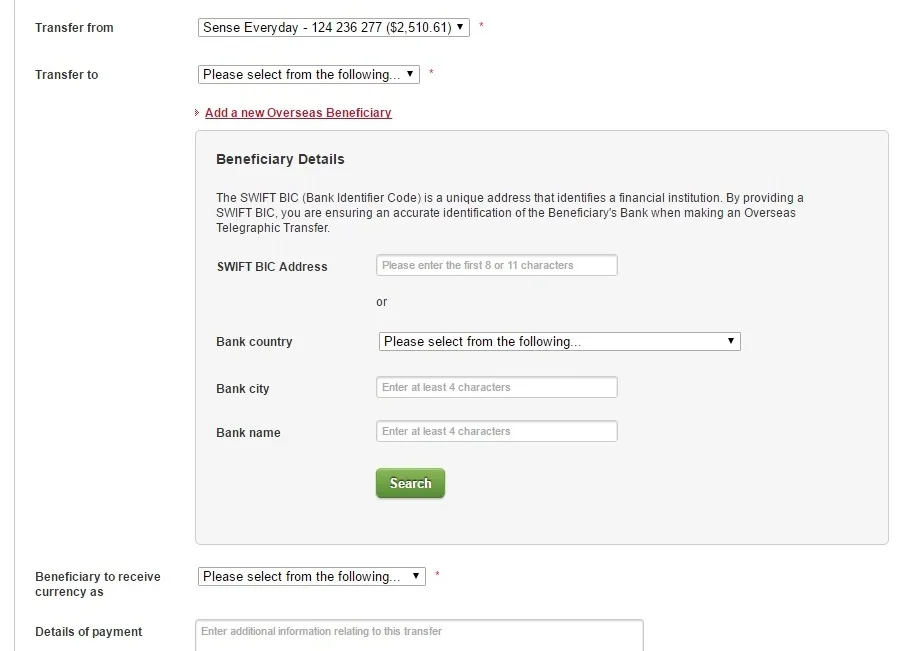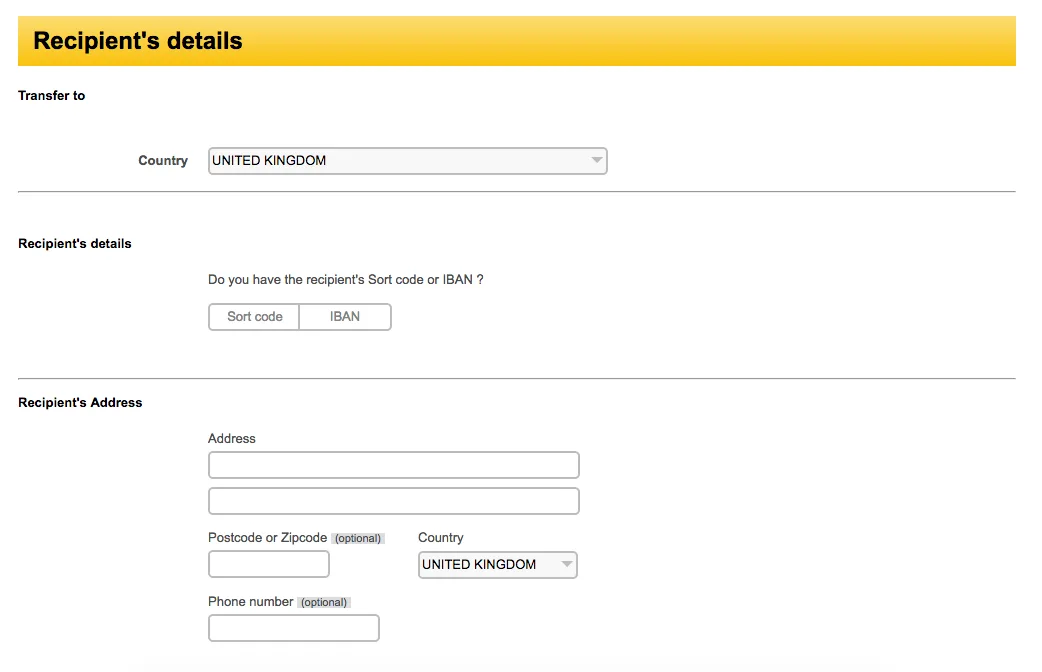Thanks to modern technology and the rise of online banking, it’s quicker and easier than ever before to send money overseas. From banks to specialist online transfer providers, there are plenty of options to choose from when you need to transfer funds across international borders.
But do you know what information you need to provide to ensure that your funds arrive in the right account straight away? This guide explains all the bank account details you need to supply to safely send or receive an international money transfer.
Sending an international money transfer online
Regardless of whether you choose to send a transfer through your Internet banking account or using a specialist online transfer company such as OFX, the details you need to provide remain the same.
You must supply:
- The recipient’s name
- The account name
- The recipient’s home address (supplying this information is optional with some providers)
- The recipient’s account number
Based on the country you are transferring funds to, you may also need to supply one of the following:
- Bank and branch
- IBAN (International bank account number)
- ABA (American Bankers Association) routing number
- IFSC (Indian Financial System Code)
- SWIFT (Society for Worldwide Interbank Financial Telecommunication) or BIC (Bank Identifier Code)
For example, the ABA routing number is used to identify banks in the United States and you will need to provide it or a SWIFT for transfers to that country, while if you’re sending a transfer to Europe you will need the IBAN and the SWIFT of the recipient’s bank. Your bank or money transfer provider will be able to provide specific information about the bank details you need to supply during the transfer process.
Apart from your recipient’s bank account details, you will also need to provide some specific details about the transfer, including:
- The currency you wish to send
- The amount you are sending
- The purpose of the transfer
Sending an international cash transfer in person
This service is offered by providers such as Western Union and MoneyGram, allowing you to send fast cash transfers to hundreds of thousands of pickup locations around the world. The details you need to provide when sending a cash transfer are a little different, as you will typically need to supply:
- Photo identification for yourself (a passport or driver’s licence will do)
- Your recipient’s full name (this must match the recipient’s name as it appears on their ID)
- Your recipient’s address
- Money to complete the transaction
It’s also worth remembering that you will need to be at least 18 years of age to send a transfer overseas.
Receiving an online international money transfer
If someone wants to transfer money to you from an overseas bank account, you’ll need to make sure they have all the relevant details needed to complete the transaction. These include:
- Your name
- The name of your bank
- Your bank’s BIC/SWIFT code
- Your bank’s BSB (Bank State Branch) number
- Your account number
- Your address
- Your e-mail address
IBANs are not used in Canada, but banks and transfer providers in some countries will require an IBAN to be provided before the transfer can be processed. You can contact your provider to find out how they would like this field populated.
It’s also worth pointing out that you may be charged a fee by your bank for receiving an international transfer. For example, TD Bank charges customers up to $17.50 for transfers received into Canadian accounts.
Receiving an international cash transfer
If you’re visiting a transfer provider’s branch to collect a cash transfer, you will need to provide:
- Photo ID, for example your driver’s licence or passport
- The reference number quoted to you by the person who sent the transfer
Depending on the size of the transfer, you may need to phone ahead to confirm that the agent has sufficient cash to complete the transaction. This is also useful if you need to check a branch’s location or opening hours.
Top tips for sending or receiving an international money transfer
Check details carefully
It’s your responsibility to ensure that the bank account details you provide for your recipient are correct. If you make a mistake and the funds are sent to the wrong account, there’s no guarantee that you’ll be able to recover those funds.
Check the exchange rate
Exchange rates vary from one transfer provider to the next, and even a minor variation in rates can make a big difference to the affordability of a transfer. Search for a provider that consistently offers competitive exchange rates.
Be aware of transfer fees
Make sure you’re aware of the fee the bank or money transfer provider charges for handling the transfer, and check whether the receiving bank will take a cut by imposing its own fees.
Use a reputable transfer provider
Make sure that any transfer provider you choose is reputable and trustworthy before handing over any bank details or money. The last thing you want to do is disclose your own or your recipient’s account information to a dodgy company.
Follow up questions about your documentation
What information do I need to provide when I send or receive an international money transfer via PayPal?
When sending money via PayPal, you’ll need to provide the email address or mobile phone number of your recipient, as well as the details of the bank account or credit card used to fund the transaction. As for receiving payments, you will need to provide your name, address, phone number and email address to open a free PayPal account.
Can I pay for an international money transfer using my credit card?
Yes, this option is available with some transfer providers, but typically only with companies that offer cash pickup transfers.
Will I need to sign up for an account before I send a transfer?
Yes, if using an online transfer company you will need to register for an account before you can send any money. Signing up is usually free. Some companies may require you to upload documents to verify your identity online.
Should I send a transfer via my bank or a specialist transfer company?
That’s entirely up to you. The advantage of using your bank is that it’s convenient, as you will most likely already have an account established from which you can transfer funds. However, in most cases, the better exchange rates and lower fees charged by online transfer companies mean that they are often a more affordable option.
What recipient bank account details will I need to provide when sending funds to India?
You will need to supply a SWIFT and an IFSC number for your recipient’s bank, as well as a reason for your transfer.
What recipient bank account details will I need to provide when sending funds to China?
You will need to provide a SWIFT for your recipient’s bank.
More guides on Finder
-
Alternatives to TorFX
Looking for alternatives to TorFX for sending money abroad? Check out these reputable money transfer services.
-
How to pay off an overseas debt
Paying off an overseas debt with an international money transfer can lead to huge savings on fees and interest.
-
How to send money to someone without a bank account
Transfer agents, mobile wallets and online credit card payments don’t necessarily require a bank account.
-
Apps like Remitly
Browse money transfer services like Remitly to see if you can send send money overseas faster and cheaper.
-
10 apps like Venmo in Canada
We compare 10 Venmo alternatives to help you find the mobile payment app that suits you.
-
4 Wise alternatives in Canada
Looking for a money transfer service like Wise? Check out these four Wise alternatives.
-
Best money transfer apps
Fast, affordable, safe and easy to use — these are the best money transfer apps in Canada.
-
Fastest ways to make a money transfer
Learn more about transferring money overseas quickly, easily and safely in an emergency.
-
How long does an international wire transfer take?
Ever wondered how long it takes for an international wire transfer to arrive in your recipient’s bank account? Find out here.


